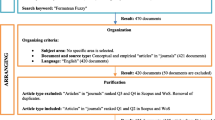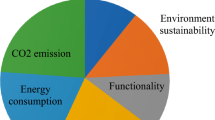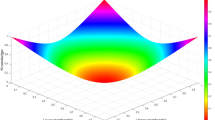Abstract
The objective of the presented paper is to develop a multiattribute decision-making (MADM) method under the intuitionistic fuzzy set (IFS) environment using the set pair analysis (SPA) theory. IFS can express the uncertain information in terms of membership grades, while the connection number (CN) based on the “identity,” “discrepancy” and “contrary” degrees of the SPA theory handles the uncertainties and certainties systems. Meanwhile, capturing the relationship between the values during the aggregation is a prominent advantage of the power aggregation operator. Motivated by these primary characteristics, in this paper, we develop some power geometric aggregation operators namely for aggregating the CNs, namely, CN power geometric, CN weighted power geometric and CN ordered weighted power geometric operators. A few properties like idempotency, commutativity and boundedness are established to show the viability and legitimacy of developed operators. Afterward, we develop a decision-making (DM) approach based on the proposed operators for tackling the MADM issues under the intuitionistic fuzzy numbers environment. Finally, real-life case of MADM problem has been discussed to manifest the developed DM approach, and obtained results are compared with the results that are obtained by the existing DM methods for showing the feasibility and validity of the developed DM approach.
Similar content being viewed by others
References
Garg, H.: Generalized intuitionistic fuzzy interactive geometric interaction operators using Einstein t-norm and t-conorm and their application to decision making. Comput. Ind. Eng. 101, 53–69 (2016)
Garg, H.; Rani, D.: Complex interval- valued intuitionistic fuzzy sets and their aggregation operators. Fundamenta Informaticae 164(1), 61–101 (2019)
Zadeh, L.A.: Fuzzy sets. Inf. Control 8, 338–353 (1965)
Atanassov, K.T.: Intuitionistic fuzzy sets. Fuzzy Sets Syst. 20, 87–96 (1986)
Atanassov, K.; Gargov, G.: Interval-valued intuitionistic fuzzy sets. Fuzzy Sets Syst. 31, 343–349 (1989)
Chen, Z.; Liu, P.; Pei, Z.: An approach to multiple attribute group decision making based on linguistic intuitionistic fuzzy numbers. J. Comput. Intell. Syst. 8(4), 747–760 (2015)
Garg, H.; Kumar, K.: Linguistic interval-valued atanassov intuitionistic fuzzy sets and their applications to group decision-making problems. IEEE Trans. Fuzzy Syst. (2019). https://doi.org/10.1109/TFUZZ.2019.2897961
Xu, Z.S.: Intuitionistic fuzzy aggregation operators. IEEE Trans. Fuzzy Syst. 15, 1179–1187 (2007)
Xu, Z.S.; Yager, R.R.: Some geometric aggregation operators based on intuitionistic fuzzy sets. Int. J. Gen. Syst. 35, 417–433 (2006)
Garg, H.: Some series of intuitionistic fuzzy interactive averaging aggregation operators. SpringerPlus 5(1), 999 (2016). https://doi.org/10.1186/s40064-016-2591-9
Garg, H.: Novel intuitionistic fuzzy decision making method based on an improved operation laws and its application. Eng. Appl. Artif. Intell. 60, 164–174 (2017)
Ye, J.: Intuitionistic fuzzy hybrid arithmetic and geometric aggregation operators for the decision-making of mechanical design schemes. Appl. Intell. 47, 743–751 (2017)
Garg, H.: Intuitionistic fuzzy hamacher aggregation operators with entropy weight and their applications to multi-criteria decision-making problems. Iran. J. Sci. Technol. Trans. Electr. Eng. (2019). https://doi.org/10.1007/s40998-018-0167-0
Huang, J.Y.: Intuitionistic fuzzy Hamacher aggregation operator and their application to multiple attribute decision making. J. Intell. Fuzzy Syst. 27, 505–513 (2014)
Wang, W.; Liu, X.: Intuitionistic fuzzy information aggregation using einstein operations. IEEE Trans. Fuzzy Syst. 20(5), 923–938 (2012)
Kaur, G.; Garg, H.: Generalized cubic intuitionistic fuzzy aggregation operators using t-norm operations and their applications to group decision-making process. Arab. J. Sci. Eng. 44(3), 2775–2794 (2019)
Singh, S.; Garg, H.: Symmetric triangular interval type-2 intuitionistic fuzzy sets with their applications in multi criteria decision making. Symmetry 10(9), 401 (2018). https://doi.org/10.3390/sym10090401
Xu, Z.: Approaches to multiple attribute group decision making based on intuitionistic fuzzy power aggregation operators. Knowl.-Based Syst. 24(6), 749–760 (2011)
Kaur, G.; Garg, H.: Cubic intuitionistic fuzzy aggregation operators. Int. J. Uncertain. Quantif. 8(5), 405–427 (2018)
Goyal, M.; Yadav, D.; Tripathi, A.: Intuitionistic fuzzy genetic weighted averaging operator and its application for multiple attribute decision making in E-learning. Indian J. Sci. Technol. 9(1), 1–15 (2016)
Zhou, W.; Xu, Z.: Extreme intuitionistic fuzzy weighted aggregation operators and their applications in optimism and pessimism decision-making processes. J. Intell. Fuzzy Syst. 32, 1129–1138 (2017)
Singh, S.; Garg, H.: Distance measures between type-2 intuitionistic fuzzy sets and their application to multicriteria decision-making process. Appl. Intell. 46(4), 788–799 (2017)
Wang, W.C.; Xu, D.M.; Chau, K.W.; Lei, G.J.: Assessment of river water quality based on theory of variable fuzzy sets and fuzzy binary comparison method. Water Resour. Manag. 28(12), 4183–4200 (2014)
Rani, D.; Garg, H.: Distance measures between the complex intuitionistic fuzzy sets and its applications to the decision—making process. Int. J. Uncertain. Quantif. 7(5), 423–439 (2017)
He, Y.; Chen, H.; Zhau, L.; Liu, J.; Tao, Z.: Intuitionistic fuzzy geometric interaction averaging operators and their application to multi-criteria decision making. Inf. Sci. 259, 142–159 (2014)
Chen, S.M.; Chang, C.H.: Fuzzy multiattribute decision making based on transformation techniques of intuitionistic fuzzy values and intuitionistic fuzzy geometric averaging operators. Inf. Sci. 352–353, 133–149 (2016)
Joshi, D.; Kumar, S.: Intuitionistic fuzzy entropy and distance measure based TOPSIS method for multi-criteria decision making. Egypt. Inform. J. 15(2), 97–104 (2014)
Yager, R.R.: The power average operator. IEEE Syst. Man Cybern. Soc. 31(6), 724–731 (2001)
Xu, Z.; Yager, R.R.: Power—geometric operators and their use in group decision making. IEEE Trans. Fuzzy Syst. 18(1), 94–105 (2010)
Garg, H.; Arora, R.: Generalized intuitionistic fuzzy soft power aggregation operator based on t-norm and their application in multi criteria decision-making. Int. J. Intell. Syst. 34(2), 215–246 (2019)
Rani, D.; Garg, H.: Complex intuitionistic fuzzy power aggregation operators and their applications in multi-criteria decision-making. Expert Syst. 35(6), e12325 (2018). https://doi.org/10.1111/exsy.12325
Zhao, K.: Set pair and set pair analysis-a new concept and systematic analysis method. In: Proceedings of the National Conference on System Theory and Regional Planning, pp. 87 – 91 (1989)
Jiang, Y.L.; Xu, C.F.; Yao, Y.; Zhao, K.Q.: Systems information in set pair analysis and its applications. In: Proceedings of 2004 International Conference on Machine Learning and Cybernetics, Vol. 3, pp. 1717 – 1722 (2004)
ChangJian, W.: Application of the set pair analysis theory in multiple attribute decision-making. J. Mech. Strength 6(029), 1009–1012 (2007)
Lu, W.S.; Zhang, B.: Set pair analysis method of containing target constraint mixed interval multi-attribute decision-making. In: Applied Mechanics and Materials, Vol. 226, pp. 2222–2226. Trans Tech Publ (2012)
Xie, Z.; Zhang, F.; Cheng, J.; Li, L.: Fuzzy multi-attribute decision making methods based on improved set pair analysis. In: Sixth International Symposium on Computational Intelligence and Design, Vol. 2, pp. 386–389 (2013)
Kumar, K.; Garg, H.: TOPSIS method based on the connection number of set pair analysis under interval-valued intuitionistic fuzzy set environment. Comput. Appl. Math. 37(2), 1319–1329 (2018)
Kumar, K.; Garg, H.: Connection number of set pair analysis based TOPSIS method on intuitionistic fuzzy sets and their application to decision making. Appl. Intell. 48(8), 2112–2119 (2018)
Cao, Y.X.; Zhou, H.; Wang, J.Q.: An approach to interval-valued intuitionistic stochastic multi-criteria decision-making using set pair analysis. Int. J. Mach. Learn. Cybern. 9(4), 629–640 (2018)
Fu, S.; Zhou, H.: Triangular fuzzy number multi-attribute decision-making method based on set-pair analysis. J. Softw. Eng. (2016). https://doi.org/10.3923/jse.2016
Garg, H.; Kumar, K.: Distance measures for connection number sets based on set pair analysis and its applications to decision making process. Appl. Intell. 48(10), 3346–3359 (2018)
Garg, H.; Kumar, K.: An advanced study on the similarity measures of intuitionistic fuzzy sets based on the set pair analysis theory and their application in decision making. Soft Comput. 22(15), 4959–4970 (2018)
Hu, J.; Yang, L.: Dynamic stochastic multi-criteria decision making method based on cumulative prospect theory and set pair analysis. Syst. Eng. Procedia 1, 432–439 (2011)
Garg, H.; Kumar, K.: A novel exponential distance and its based TOPSIS method for interval-valued intuitionistic fuzzy sets using connection number of SPA theory. Artif. Intell. Rev. (2018). https://doi.org/10.1007/s10462-018-9668-5
Garg, H.; Kumar, K.: A novel correlation coefficient of intuitionistic fuzzy sets based on the connection number of set pair analysis and its application. Scientia Iranica E 25(4), 2373–2388 (2018)
Garg, H.; Kumar, K.: Some aggregation operators for linguistic intuitionistic fuzzy set and its application to group decision-making process using the set pair analysis. Arab. J. Sci. Eng. 43(6), 3213–3227 (2018)
Garg, H.; Kumar, K.: Improved possibility degree method for ranking intuitionistic fuzzy numbers and their application in multiattribute decision-making. Granul. Comput. 4(2), 237–247 (2019)
Chaokai, H.; Meng, W.: A new reputation model for p2p network based on set pair analysis. Open Cybern. Syst. J. 9, 1393–1398 (2015)
Wang, X.; Triantaphyllou, E.: Ranking irregularities when evaluating alternatives by using some electre methods. Omega - Int. J. Manag. Sci. 36, 45–63 (2008)
Nancy.; Garg, H.: A novel divergence measure and its based TOPSIS method for multi criteria decision-making under single-valued neutrosophic environment. J. Intell. Fuzzy Syst. 36(1), 101–115 (2019)
Taormina, R.; Chau, K.W.; Sivakumar, B.: Neural network river forecasting through baseflow separation and binary-coded swarm optimization. J. Hydrol. 529, 1788–1797 (2015)
Sefeedpari, P.; Rafiee, S.; Akram, A.; Chau, K.W.; Pishgar-Komleh, S.H.: Prophesying egg production based on energy consumption using multi-layered adaptive neural fuzzy inference system approach. Comput. Electron. Agric. 131, 10–19 (2016)
Wu, C.; Chau, K.: Rainfall-runoff modeling using artificial neural network coupled with singular spectrum analysis. J. Hydrol. 399(3–4), 394–409 (2011)
Chau, K.W.; Cao, Y.; Anson, M.; Zhang, J.: Application of data warehouse and decision support system in construction management. Autom. Constr. 12(2), 213–224 (2003)
Arora, R.; Garg, H.: Group decision-making method based on prioritized linguistic intuitionistic fuzzy aggregation operators and its fundamental properties. Comput. Appl. Math. 38(2), 1–36 (2019)
Garg, H.; Kumar, K.: An extended technique for order preference by similarity to ideal solution group decision making method with linguistic interval-valued intuitionistic fuzzy information. J. Multi-Criteria Decis. Anal. 26(1–2), 16–26 (2019)
Garg, H.; Nancy.: Algorithms for possibility linguistic single-valued neutrosophic decision-making based on COPRAS and aggregation operators with new information measures. Measurement 138, 278–290 (2019)
Author information
Authors and Affiliations
Corresponding author
Rights and permissions
About this article
Cite this article
Garg, H., Kumar, K. Power Geometric Aggregation Operators Based on Connection Number of Set Pair Analysis Under Intuitionistic Fuzzy Environment. Arab J Sci Eng 45, 2049–2063 (2020). https://doi.org/10.1007/s13369-019-03961-0
Received:
Accepted:
Published:
Issue Date:
DOI: https://doi.org/10.1007/s13369-019-03961-0




